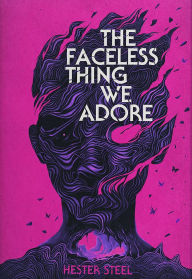The Heart of It: A Guest Post by Hester Steel
After ditching her job to join a commune, Aoife is ready for a quiet and tranquil farm life. But as she integrates herself among the curious community, Aoife begins to question her reality as old traumas resurface in this vibrant mind-bending thriller. Read on for an exclusive essay from author Hester Steel on writing The Faceless Thing We Adore.
The Faceless Thing We Adore
The Faceless Thing We Adore
By Hester Steel
In Stock Online
Hardcover
$24.99
$27.99
Eat, Pray, Love goes full Lovecraft in this queer, feel-good cosmic horror that reflects on gaslighting and emotional abuse.
Eat, Pray, Love goes full Lovecraft in this queer, feel-good cosmic horror that reflects on gaslighting and emotional abuse.
I can pinpoint the exact moment The Faceless Thing We Adore came into being, which is why it’s so ridiculous that it took so many attempts to get to the heart of it. I’d been lucky enough to get to do two research semesters abroad for my masters’ degree, one at a university in Bangkok (admittedly about as different a place from the setting of this book as you can get) and one on a small Mediterranean island (slightly closer). Teenage me, stuck in rural England with her copies of The Beach and On The Road falling apart from over-reading and with her constant haunting of the travel section of the local library, would have been delighted.
While I was in Bangkok, the phrase Eat Pray Lovecraft floated through my brain on my morning commute one day, an echo of a running joke with a friend. Perhaps it was the effect of having lived the past few months in a guesthouse with a constant stream of backpackers on journeys of self-discovery passing through, but the idea instantly clicked into place. What if one of those travel-fuelled spiritual awakenings involved joining a cult worshipping an eldritch horror?
The book that was initially born in my head was a horror comedy, and the book I ended up drafting over the following months was closer to a young adult fantasy. Seriously. Fortunately or unfortunately, around that time I returned to London and London went straight into lockdown, leaving me alone with nothing much to do except immerse myself in researching cults (and of course rewatching Midsommar). I realised that the story here was a darker but much more interesting one, and I triumphantly sat down and wrote another book that was also not this one.
It was only after a few years that I finally hit on the truth – or rather, was bludgeoned by the truth in the form of repeated agent rejections. The book I’d written, a dual POV horror-fantasy about warring cults and the tensions between tourists and locals, wasn’t the one that I’d meant to write. But the seed of it was there in one character, a sheltered and idealistic traveller fleeing a manipulative ex and seeking belonging – and ultimately power. She was the heart of the book, and her struggle to escape the people pulling her strings without inadvertently becoming just like them was the heart of the story.
I dug that seed out, planted it in new soil, and managed to grow a book, and one that was a lot more personal than I’d planned for it to be. With each draft it crystallised that this was a story about manipulation and control, and about the fight to form bonds in the face of it, and the joy and danger of breaking free in rage. As well as, of course, being about warm peaches and yoghurt, beach parties, girls kissing in libraries, and eldritch horrors lurking in sea caves. And perhaps about small-town girls who find the outside world very different to what they dreamed about, but try to forge themselves a home in it anyway.

